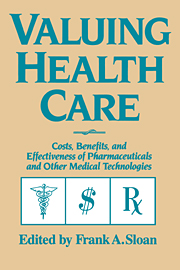 Valuing Health Care
Valuing Health Care Book contents
- Frontmatter
- Contents
- List of Tables
- List of Figures
- List of Boxes
- Acknowledgments
- 1 Introduction
- 2 Evidence of effectiveness: evaluating its quality
- 3 Utility assessment for estimating quality-adjusted life years
- 4 Measuring costs
- 5 From cost–effectiveness ratios to resource allocation: where to draw the line?
- 6 Valuing health care benefits in money terms
- 7 Discounting health effects for medical decisions
- 8 Statistical issues in cost–effectiveness analyses
- 9 Decision trees and Markov models in cost–effectiveness research
- 10 The use of cost–effectiveness/cost–benefit analysis in actual decision making: current status and prospects
- Notes
- References
- Index
4 - Measuring costs
Published online by Cambridge University Press: 07 December 2009
- Frontmatter
- Contents
- List of Tables
- List of Figures
- List of Boxes
- Acknowledgments
- 1 Introduction
- 2 Evidence of effectiveness: evaluating its quality
- 3 Utility assessment for estimating quality-adjusted life years
- 4 Measuring costs
- 5 From cost–effectiveness ratios to resource allocation: where to draw the line?
- 6 Valuing health care benefits in money terms
- 7 Discounting health effects for medical decisions
- 8 Statistical issues in cost–effectiveness analyses
- 9 Decision trees and Markov models in cost–effectiveness research
- 10 The use of cost–effectiveness/cost–benefit analysis in actual decision making: current status and prospects
- Notes
- References
- Index
Summary
Ideals and realities in cost measurement
Medical treatment involving pharmaceuticals usually requires a substantial number and variety of additional medical resources. During a patient's hospital stay, for example, personnel, including nurses, technicians, therapists, and orderlies, will allocate some of their time to caring for and attending to the patient's many needs. In addition to these labor inputs, the attending physician may order the use of expensive equipment for diagnosis and treatment. Other medical supplies must be obtained and administered. Pharmaceutical treatment in other settings involves a similarly wide anay of medical resources. The other principal resource used in the medical process is the time of the patient and his or her family.
When resources are used to provide medical care for one patient, they are unavailable for other patients and other societal uses. Thus, one cannot judge the merits of a medical intervention without understanding what one is giving up to provide that intervention. What providers and society give up to provide treatment for an individual is called the cost of the treatment.
This chapter presents a series of conceptual guidelines to help the researcher measure the costs of medical treatment. The fundamental economic concept of opportunity cost is introduced first. This concept is essential to understanding the importance of perspective, which is discussed in the next section. These points are then used to show how the analyst can determine which costs should be included in the analysis.
- Type
- Chapter
- Information
- Valuing Health CareCosts, Benefits, and Effectiveness of Pharmaceuticals and Other Medical Technologies, pp. 61 - 76Publisher: Cambridge University PressPrint publication year: 1995
- 11
- Cited by


